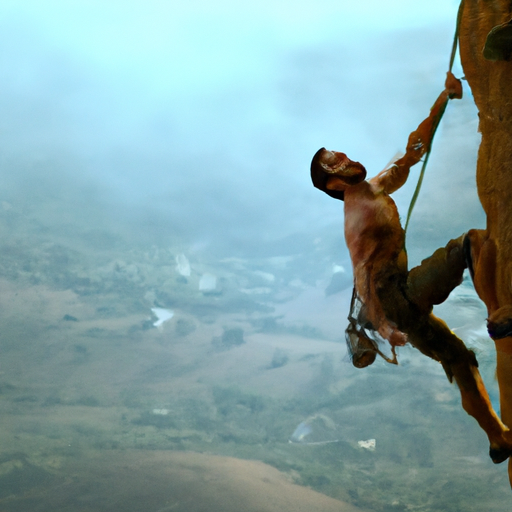
So you’re curious about what muscles climbing works, huh? Well, let me fill you in! When you challenge yourself to conquer that rock wall or climb up a mountain, you engage a whole bundle of muscles in your body. From your fingertips to your toes, climbing targets numerous muscle groups, making it an excellent full-body workout.
First off, let’s talk about those upper body muscles. As you pull yourself up, your biceps and forearms get a serious workout. Not only that, but your shoulders and back muscles also kick into action to help stabilize and control your movements. And don’t forget about your chest muscles, which play a role in pushing and pulling during different climbing positions.
Moving on down, your core muscles, including your abs and obliques, come into play. By engaging your core, you maintain stability and balance, ultimately aiding your climbing efforts. Now, let’s not neglect those lower body muscles. Your quadriceps, hamstrings, and glutes work together to provide the power and strength needed to propel yourself upward. Additionally, your calves and even your toes help with gripping and maintaining control on the climbing surface.
So, as you can see, climbing is no joke when it comes to working out your entire body. It’s a challenging and rewarding activity that targets a wide range of muscles, helping you build strength and endurance. Whether you’re a beginner or a seasoned climber, get ready to feel the burn and enjoy the exhilaration of conquering new heights!

Benefits of Climbing
Climbing is a fantastic activity that not only challenges us physically, but also provides us with a multitude of benefits. From engaging numerous muscle groups to improving balance and stability, climbing offers a holistic workout experience that integrates both the mind and body. In this article, we will explore the various muscle groups that are targeted during climbing and delve into the specific benefits associated with each.
General muscle engagement
One of the key benefits of climbing is its ability to engage a wide range of muscles throughout the body. Whether you’re scaling a challenging rock wall or conquering a bouldering route, climbing demands substantial effort from your upper body, core, and lower body. By working multiple muscle groups simultaneously, climbing is an efficient way to build strength and increase overall fitness.
Upper body focus
Climbing places a considerable emphasis on upper body strength. The muscles of the upper body that are particularly targeted during climbing include the forearm flexors, which play a crucial role in gripping and holding onto climbing holds. Additionally, the biceps brachii, triceps brachii, deltoids, trapezius, latissimus dorsi, rhomboids, pectoralis major, and the rotator cuff muscles all contribute to the complex movements involved in climbing.
Core activation
A strong and stable core is vital for climbing success. The core muscles, including the rectus abdominis, obliques, transversus abdominis, erector spinae, and multifidus, provide the foundational strength necessary for climbing movements. These muscles not only generate power during dynamic moves but also help maintain balance and stability on the wall.

Lower body strength
While upper body strength plays a significant role in climbing, it is essential not to overlook the importance of lower body strength. Muscles such as the quadriceps, hamstrings, glutes, calves, and hip flexors are all engaged during climbing to support lower body movements, help with balance, and propel climbers up the wall.
Grip and Forearm Muscles
A firm grip is crucial for climbers, and strong forearm muscles are the key to achieving it. Climbing targets muscles such as the flexor digitorum profundus, flexor digitorum superficialis, flexor pollicis longus, extensor digitorum, pronator teres, brachioradialis, and supinator. By regularly engaging these muscles through climbing, your grip strength will improve, allowing you to tackle more challenging routes with confidence.

Balance and Stabilizing Muscles
Maintaining balance and stability is essential in climbing, and specific muscles are responsible for these crucial functions. The tibialis anterior, peroneus longus, gastrocnemius, soleus, and quadratus lumborum all work synergistically to keep the climber steady and in control while negotiating different climbing surfaces and challenging terrains.
Breathing and Cardiovascular Muscles
Climbing is not just about physical strength; it also requires efficient breathing and cardiovascular conditioning. The diaphragm, intercostal muscles, serratus anterior, and scalenes are all involved in the breathing process during climbing, ensuring sufficient oxygen intake and aiding in endurance.

Flexibility and Mobility
In addition to strength and stability, climbing also promotes flexibility and mobility. Climbers often rely on hip flexor mobility to achieve high steps and shoulder mobility to reach for holds. Furthermore, maintaining spinal mobility is crucial for climbers, as it allows for more fluid movements and better positioning on the wall.
Injury Prevention and Rehabilitation
With any physical activity, injury prevention and rehabilitation are important considerations. Climbers can benefit from specific exercises that target key areas prone to injury. Strengthening the rotator cuff muscles helps prevent shoulder injuries, while scapular stability exercises contribute to overall shoulder health. Additionally, performing wrist and finger exercises and focusing on ankle and foot mobilization can aid in injury prevention and facilitate a faster recovery in case of any climbing-related mishaps.

Conclusion
Engaging in climbing offers a multitude of benefits for both the body and mind. By working and strengthening various muscle groups, climbers experience a holistic workout that improves functional movements required in daily life. The integration of mind and body while navigating challenging routes not only builds physical strength but also promotes mental resilience and focus. So, whether you’re a seasoned climber or a novice looking to try something new, the benefits of climbing are numerous and undeniable. Embrace the challenge, harness your physical potential, and enjoy the rewarding journey that climbing has to offer.
